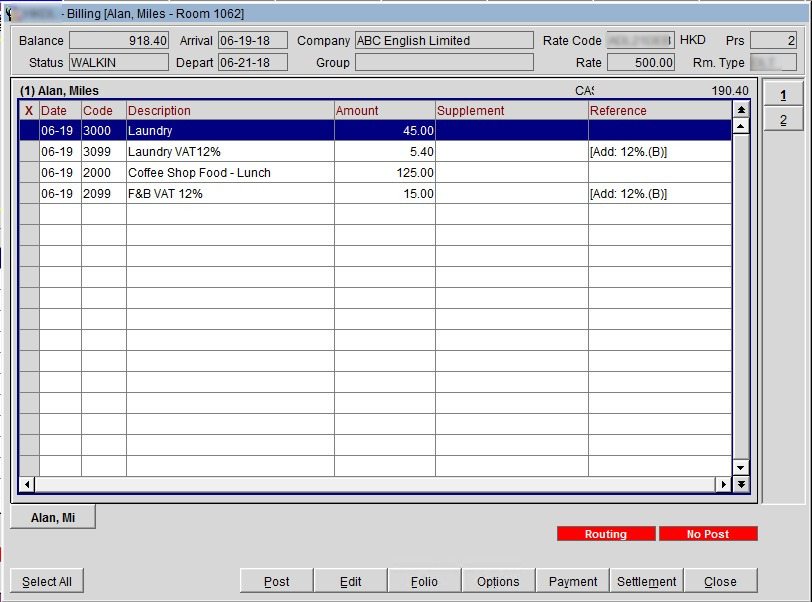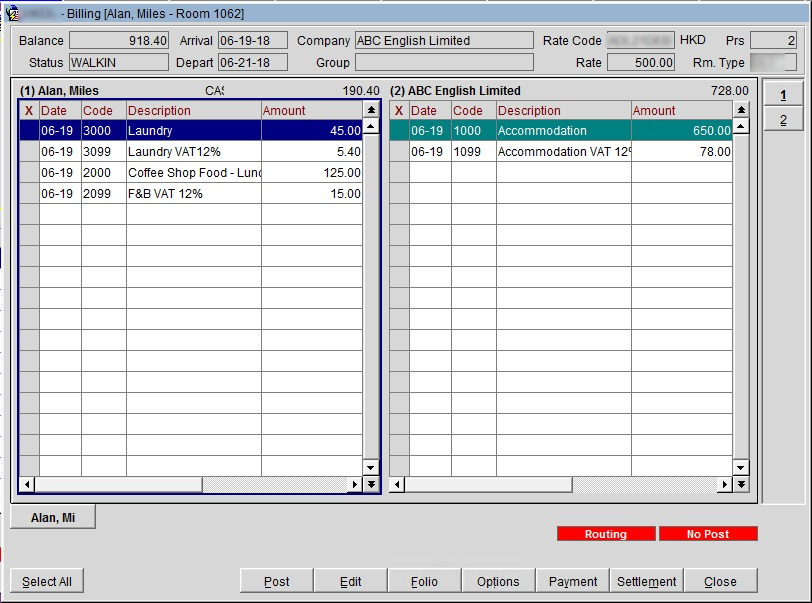What is a hotel bill? Hotel billing might sound simple, just charges and payments, right? But behind the scenes, it involves folios, room charges, taxes, incidental fees, and payment processing. Whether you’re a hotelier or a guest, understanding how hotel billing works helps avoid confusion and ensures transparency.
In this guide, we’ll break down hotel billing step by step, define common billing terms, and share tips for smooth billing operations in your hotel.
Briefly, the billing with its itemized postings acts as a statement of charges throughout the guest’s stay. When you print this billing, it becomes an invoice, which in hotels’ terms, is a guest folio. And, after the guest checks out, the financial data stays with the guest’s profile in the hotel management software for historical and statistical purposes.
Billing Terms Summary Table
| Term | What It Means |
|---|---|
| Folio | A guest’s billing record showing all charges, payments, and adjustments |
| Incidental Fees | Additional charges like minibar use, late checkout, room service |
| Room Charges | Base cost of the room before extras and taxes |
| Taxes | Local/state taxes applied to the guest’s bill |
| Payment Method | Credit card, cash, corporate account, or digital wallet |
| Split Billing | When a guest pays different charges using multiple methods |
| Group Folio | Combined bill for multiple rooms or guests under one reservation |
If you’re looking for hotel billing software, check out here for a comparison. Or, if you’re looking for modern billing tools, check out the Best Hotel PMS for 2025
If you want to learn more on:
Let’s, have a look at what a typical guest billing window in a hotel looks like:

How Hotel Billing Works (Step-by-Step)
Hotel billing begins at check-in and continues until checkout. Here’s a simplified breakdown:
- Reservation Confirmation – Guest provides a payment method to hold the booking.
- Pre-Authorization – Many hotels pre-authorize a certain amount on the guest’s card.
- Daily Charges – Each night, charges like room rate and taxes are added to the folio.
- Incidental Charges – Any extra services (spa, minibar, room service) are logged.
- Checkout & Payment – Final charges are reviewed and settled using the chosen payment method.
The folio then becomes the guest’s official record of their stay — like an invoice.
What’s Included in a Hotel Bill?
Hotel bills can vary depending on the hotel, but typically include:
- Room charges
- Taxes and service fees
- Minibar or restaurant charges
- Laundry or valet services
- Wi-Fi or premium TV usage
- Damage or smoking fees (if applicable)
Guests should review their folio at checkout to confirm all charges are accurate.
What Are The Benefits of Hotel Billing System?
- The hotels don’t use an invoicing software even though it is a business like any other. But hotels use a comprehensive property management system which has its invoicing module for posting hotel charges.
- Hotels sell their products and services to the customers (guests) to make revenues to run the business and make a profit.
- A guest bill is opened from the time the guest checks in and closed when the guest checks out settling the bill. During this time, the hotel posts various charges on the bill and collects payment at the checkout.
- Billing is a must for printing invoices, which is a legal requirement, keeping track of guest consumption and payments. And, it is the first entry point of a journal (posting) into the hotel’s complex financial management.
Later in the post, we will simplify where a posting on a guest bill ends up on the financial reporting of a hotel.
What Is The Content of Hotel Bill?
A guest folio, which is the print copy of the billing (‘billing window’ to be precise) in a hotel should contain the following:

- The hotel info with the address and contact info.
- Addressee name: It can be the guest’s name. Depending on whom the folio is addressed, it can also be a company name or a travel agent name. In the above image, you can see two windows, one for the guest and the other for his company.
- Confirmation number (or booking number). Bookings that hotels receive through central reservation systems (if it is part of a group or hotel chain), OTAs (online travel agents), and other booking sites have an additional reference number that can also be part of the guest folio.
- It should have a stay date range. Typically, this is the date range from the check-in date until the checkout date. However, if you print the folio in the middle of the guest’s stay, it can mean it is an informational folio, which the guest might have asked to print for whatever reason. Therefore ‘Folio Type’ indication would help understand better.
- Other crucial details include room number, print date, and cashier who printed the folio.
- Then comes the transaction details with the date posted, the description of the charge, and the amount posted, which can be positive if it is debit or negative in case it is a payment or adjustment transaction. More on this under section: What is an itemized hotel bill?
- Preferably, the guest’s and the cashier’s signature on the final / settlement folio.
What Is An Itemized Hotel Bill?
An itemized bill simply means that the bill contains the details of every charge separately.
For instance, you paid $57.50 for your lunch check at the Atrium restaurant. An itemized bill should show the breakdown of your lunch check like Atrium Food: $30, Atrium Beverage $12, Tobacco $8, F&B Tax $6.3, and Tobacco Tax $1.2.
Hotels use charge codes to post each charge into the guest billing called ‘transaction codes’. These codes uniquely identify the charge type such as Atrium Food, Atrium Beverage, Tobacco, and so on.
How Does The Hotel Billing System Work?
Every PMS system has a section to handle guest billing, which works like a hotel billing software. Even though system-to-system might differ in features and user experience, they all work according to accounting principles, debits, and credits.
The List of Items In Hotel Bill
As discussed earlier section: What is an itemized hotel bill? you know what those items are. We will see briefly what defines these transaction codes.
At the top level, these charge codes can be Debit or Credit. No, not accounting here 🙂 A Debit is a charge a hotel posts when a guest consumes a hotel service or product. Credit is posted when the guest makes a payment.
Sample Debit / Credit charges (Remember, a hotel can use hundreds of charges depending on the level of details they want to track and report their revenue, for instance, they can keep it simple like Coffee Shop Food, Coffee Shop Beverage or they can drill down to Coffee Shop Food – Breakfast, etc., you got the point):
| Debit postings | Credit postings |
| Accommodation | Cash |
| Extra Bed | Maater Card |
| No Show Charges | Visa Card |
| Cancelation Charges | Master Card |
| Accommodation Rebate | Amex |
| Coffee Shop Food | Cash Deposit |
| Coffee Shop Beverage | Master Card – Deposit |
| Coffee Shop Package | Visa Card – Deposit |
| Laundry | Bank Transfer |
| Telephone | JCB |
| Recreation | AliPay |
| Tax | Wire Transfer |
| Service Charge | Check |
| Restaurant Tips | City Ledger (Direct Bill) |
What Are The Types of Hotel Revenue?
If the transaction code is of ‘debit’ type, it should contribute to one of the below revenue types (revenue buckets) for the hotel to evaluate how each of the major sources performs and for other reporting and revenue management purposes:
| Lodging: Rooms revenue, a major source of revenue for hotels. | Taxes: Government levy, this is not a revenue to hotels, but they need to track this for taxation. |
| Food & Beverage: The second most revenue source. | Non-revenue: This is also not revenue for hotels but these are not government levies. For instance, Service Charges or posting of taxi fares. In both cases, the payment is collected by the hotel to pay back to someone else. |
| Miscellaneous (Others): This includes charges from laundry, telephones, minibars, spas, health clubs, business-center, or anything that is not the first two described. |
Revenue type is not a concern of any guest, they help hotel operations only.
What’s the Difference Between a Folio and an Invoice?
A folio is the ongoing record of a guest’s charges during their stay. It’s updated daily and shows all expenses in real-time.
An invoice, on the other hand, is usually the finalized version of the folio — issued at checkout as a summary of the full bill.
In many hotels, the terms are used interchangeably, but technically:
- Folio = Live billing record
- Invoice = Finalized statement
See also: What is a Hotel Folio?
FAQ – Frequently Asked Questions
What is billing in a hotel?
Hotel billing refers to the process of recording, calculating, and settling all charges incurred by a guest during their stay including room rates, taxes, and incidental expenses.
What is a hotel folio used for?
A hotel folio serves as a detailed account of all guest transactions and is used for review and final payment at checkout. It’s essentially the guest’s receipt.
Can hotel bills be split?
Yes, most hotels allow split billing — where charges are divided between multiple payment methods or guests. This is common for business trips or shared stays.


3 Comments
[…] any of the hotel’s products or services, the payment is an advanced deposit. Deposits sit in a guest’s bill as a credit, meaning the hotel always owes the guest this money, if it is not used against charges […]
[…] Hotel Billing: What Is Hotel Billing Process? […]
[…] Hotel Billing: What Is Hotel Billing Process? […]